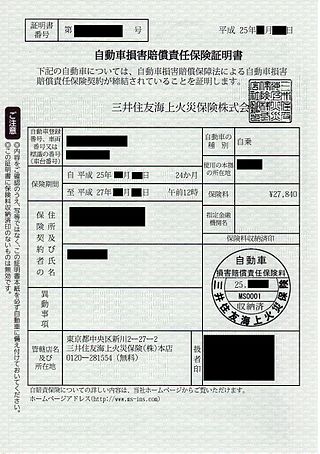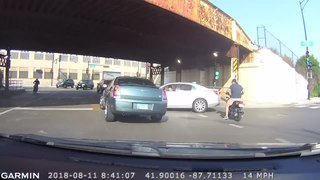
Forensic engineering has been defined as "the investigation of failures—ranging from serviceability to catastrophic—which may lead to legal activity, including both civil and criminal". The forensic engineering field is very broad in terms of the many disciplines that it covers, investigations that use forensic engineering are case of environmental damages to structures, system failures of machines, explosions, electrical, fire point of origin, vehicle failures and many more.

A rear-end collision, often called rear-ending or, in the UK, a shunt, occurs when a forward-moving vehicle crashes into the back of another vehicle in front of it. Similarly, rear-end rail collisions occur when a train runs into the end of a preceding train on the same track. Common factors contributing to rear-end collisions include driver inattention or distraction, tailgating, panic stops, brake checking and reduced traction due to wet weather or worn pavement.

Vehicle insurance is insurance for cars, trucks, motorcycles, and other road vehicles. Its primary use is to provide financial protection against physical damage or bodily injury resulting from traffic collisions and against liability that could also arise from incidents in a vehicle. Vehicle insurance may additionally offer financial protection against theft of the vehicle, and against damage to the vehicle sustained from events other than traffic collisions, such as vandalism, weather or natural disasters, and damage sustained by colliding with stationary objects. The specific terms of vehicle insurance vary with legal regulations in each region.
This article addresses torts in United States law. As such, it covers primarily common law. Moreover, it provides general rules, as individual states all have separate civil codes. There are three general categories of torts: intentional torts, negligence, and strict liability torts.

Road rage is aggressive or angry behavior exhibited by people driving a vehicle. These behaviors include rude and verbal insults, yelling, physical threats or dangerous driving methods targeted at other drivers, pedestrians or cyclists in an effort to intimidate or release frustration. Road rage can lead to altercations, damage to property, assaults, and collisions that result in serious physical injuries or even death. Strategies include cutting motorists off, inappropriate honking, flashing headlights, using obscene gestures, flipping off another driver, swerving, tailgating, brake checking, and physical confrontation.
In its broadest sense, no-fault insurance is any type of insurance contract under which the insured party is indemnified by their own insurance company for losses, regardless of the source of the cause of loss. In this sense, it is similar to first-party coverage. The term "no-fault" is most commonly used in the United States, Australia, and Canada when referring to state or provincial automobile insurance laws where a policyholder and their passengers are reimbursed by the policyholder's own insurance company without proof of fault, and are restricted in their right to seek recovery through the civil-justice system for losses caused by other parties. No-fault insurance has the goal of lowering premium costs by avoiding expensive litigation over the causes of the collision, while providing quick payments for injuries or loss of property.

Personal injury is a legal term for an injury to the body, mind, or emotions, as opposed to an injury to property. In common law jurisdictions the term is most commonly used to refer to a type of tort lawsuit in which the person bringing the suit has suffered harm to their body or mind. Personal injury lawsuits are filed against the person or entity that caused the harm through negligence, gross negligence, reckless conduct, or intentional misconduct, and in some cases on the basis of strict liability. Different jurisdictions describe the damages in different ways, but damages typically include the injured person's medical bills, pain and suffering, and diminished quality of life.
An uninsured motorist clause is a provision commonly found in United States automobile insurance policies that provides for a driver to receive damages for any injury he or she receives from an uninsured, negligent driver. The owner of the policy pays a premium to the insurance company to include this clause. Although not exclusive, this coverage is typically added to an automobile insurance policy. In the event of a qualifying accident, the insurance company pays the difference between what the uninsured driver can pay and what the injured driver would be entitled to as if the uninsured motorist had proper insurance.
A car rental, hire car or car hire agency is a company that rents automobiles for short periods of time to the public, generally ranging from a few hours to a few weeks. It is often organized with numerous local branches, and primarily located near airports or busy city areas and often complemented by a website allowing online reservations.

The Motor Insurers' Bureau (MIB) was founded in the UK in 1946 as a private company limited by guarantee and is the mechanism in the UK through which compensation is provided for victims of accidents caused by uninsured and untraced drivers, which is funded by an estimated £30 a year from every insured driver's premiums.
Negligent entrustment is a cause of action in United States tort law which arises where one party is held liable for negligence because they negligently provided another party with a dangerous instrumentality, and the entrusted party caused injury to a third party with that instrumentality. The cause of action most frequently arises where one person allows another to drive their automobile.
The following outline is provided as an overview of and introduction to tort law in common law jurisdictions:

A traffic collision, also known as a motor vehicle collision, or car crash, occurs when a vehicle collides with another vehicle, pedestrian, animal, road debris, or other moving or stationary obstruction, such as a tree, pole or building. Traffic collisions often result in injury, disability, death, and property damage as well as financial costs to both society and the individuals involved. Road transport is statistically the most dangerous situation people deal with on a daily basis, but casualty figures from such incidents attract less media attention than other, less frequent types of tragedy. The commonly used term car accident is increasingly falling out of favor with many government departments and organizations, with the Associated Press style guide recommending caution before using the term and the National Union of Journalists advising against it in their Road Collision Reporting Guidelines. Some collisions are intentional vehicle-ramming attacks, staged crashes, vehicular homicide or vehicular suicide.

The eggshell rule is a well-established legal doctrine in common law, used in some tort law systems, with a similar doctrine applicable to criminal law. The rule states that, in a tort case, the unexpected frailty of the injured person is not a valid defense to the seriousness of any injury caused to them.

In traffic laws, a hit and run or a hit-and-run is the criminal act of causing a traffic collision and not stopping afterwards. It is considered a supplemental crime in most jurisdictions.
Vehicle insurance in the United States is designed to cover the risk of financial liability or the loss of a motor vehicle that the owner may face if their vehicle is involved in a collision that results in property or physical damage. Most states require a motor vehicle owner to carry some minimum level of liability insurance. States that do not require the vehicle owner to carry car insurance include New Hampshire and Mississippi, which offers vehicle owners the option to post cash bonds. The privileges and immunities clause of Article IV of the U.S. Constitution protects the rights of citizens in each respective state when traveling to another. A motor vehicle owner typically pays insurers a monthly or yearly fee, often called an insurance premium. The insurance premium a motor vehicle owner pays is usually determined by a variety of factors including the type of covered vehicle, marital status, credit score, whether the driver rents or owns a home, the age and gender of any covered drivers, their driving history, and the location where the vehicle is primarily driven and stored. Most insurance companies will increase insurance premium rates based on these factors and offer discounts less frequently.
A park-to-reverse defect is a scenario in which cars with automatic transmission can fail to properly engage the parking mechanism, causing the vehicle to unintentionally roll, sometimes resulting in injury or vehicular accidents. This has significance in product liability law, and a number of major cases in the United States have been brought in which car manufacturers were accused of negligence for not addressing an alleged dangerous flaw in the transmission.
The Motor Vehicles Act is an Act of the Parliament of India which regulates all aspects of road transport vehicles. The Act provides in detail the legislative provisions regarding licensing of drivers/conductors, registration of motor vehicles, control of motor vehicles through permits, special provisions relating to state transport undertakings, traffic regulation, insurance, liability, offences and penalties, etc. For exercising the legislative provisions of the Act, the Government of India made the Central Motor Vehicles Rules 1989.
Increases in the use of autonomous car technologies are causing incremental shifts in the control of driving. Liability for incidents involving self-driving cars is a developing area of law and policy that will determine who is liable when a car causes physical damage to persons or property. As autonomous cars shift the control of driving from humans to autonomous car technology, there is a need for existing liability laws to evolve to reasonably identify the appropriate remedies for damage and injury. As higher levels of autonomy are commercially introduced, the insurance industry may see higher proportions of commercial and product liability lines of business, while the personal automobile insurance line of business shrinks.
Sleep driving, also known as sleepwalk driving, is a rare phenomenon where the person drives a motor vehicle while they are sleepwalking. If stopped by police, sleepwalk-drivers are totally incapable of having any interaction with the police, if they are still sleepwalking during the event. Sleepwalk-driving can occur to people who normally don't experience sleepwalking, since some medications, especially zolpidem and eszopiclone, can cause sleepwalking as unwanted side effect.








